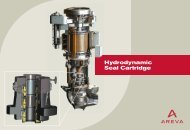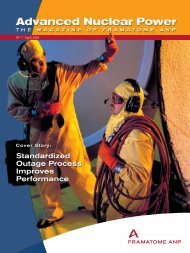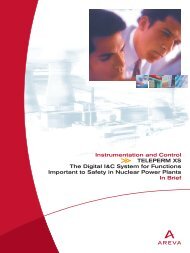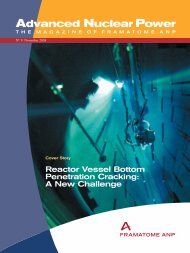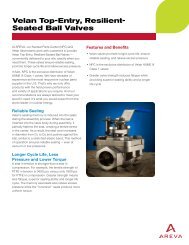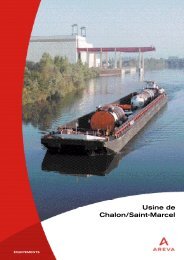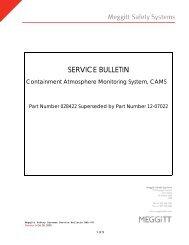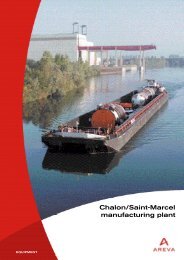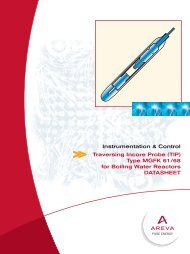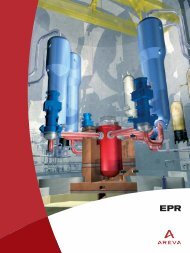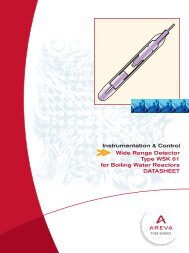Areva EPR
Areva EPR
Areva EPR
You also want an ePaper? Increase the reach of your titles
YUMPU automatically turns print PDFs into web optimized ePapers that Google loves.
■ SAFETY<br />
Greater provision for the risk arising<br />
from internal and external hazards<br />
The choices taken for the installation of the safeguard systems and<br />
the civil works minimize the risks arising from the various hazards<br />
(earthquake, flooding, fire, aircraft crash).<br />
The safeguard systems are designed on the basis of a quadruple<br />
redundancy, both for the mechanical and electrical portions and for<br />
the I & C. This means that each system is made up of four subsystems,<br />
or “trains”, each one capable by itself of fulfilling the whole<br />
of the safeguard function. The four redundant trains are physically<br />
separated from each other and geographically shared among four<br />
independent divisions (buildings).<br />
1<br />
1<br />
2<br />
1<br />
Each division includes:<br />
• for borated water safety injection into the reactor vessel in case<br />
of loss of coolant accident, a low-head injection system and<br />
its cooling loop, together with a medium-head injection system,<br />
•a steam generator emergency feedwater system,<br />
• the electrical systems and I & C linked to these systems.<br />
The building housing the reactor, the building in which the spent fuel<br />
is interim-stored, and the four buildings corresponding to the four<br />
divisions of the safeguard systems, are given special protection<br />
against externally-generated hazards such as earthquakes and<br />
explosions.<br />
This protection is further strengthened against an airplane crash.<br />
The reactor building is covered with a double concrete shell: an<br />
outer shell made of 1.30 m thick reinforced concrete and an inner<br />
shell made of pre-stressed concrete and also 1.30 m thick which is<br />
internally covered with a 6 mm thick metallic liner. The thickness and<br />
the reinforcement of the outer shell on its own have sufficient<br />
strength to absorb the impact of a military or large commercial<br />
aircraft. The double concrete wall protection is extended to the fuel<br />
building, two of the four buildings dedicated to the safeguard<br />
systems, the main control room and the remote shutdown station<br />
which would be used in a state of emergency.<br />
The other two buildings dedicated to the safeguard systems, those<br />
which are not protected by the double wall, are remote from each<br />
other and separated by the reactor building, which shelters them<br />
from simultaneous damage. In this way, should an aircraft crash<br />
occur, at least three of the four divisions of the safeguard systems<br />
would be preserved.<br />
The choices regarding the equipment<br />
and systems, in order to reduce the risk<br />
of an abnormal situation deteriorating<br />
into an accident<br />
Elimination of the risk of a large<br />
reactor coolant pipe break<br />
The reactor coolant system design, the use of forged pipes and<br />
components, construction with high mechanical performance<br />
materials, combined with the measures taken to detect leaks at the<br />
earliest time and to promote in-service inspections, practically rule out<br />
any risk of large pipe rupture.<br />
1<br />
The major safety systems comprise four sub-systems or trains, each capable<br />
of performing the entire safety function on its own. There is one train in each<br />
of the four safeguard buildings (1) surrounding the reactor building (2) to prevent<br />
common-mode failure of the trains.<br />
† A set of quadruple redundant<br />
safeguard systems, with independent<br />
and geographically separated trains,<br />
minimize consequences of potential<br />
internal and external hazards.<br />
† This protection is even reinforced<br />
against the airplane crash risk by<br />
the strong double concrete shell<br />
implemented to shelter the <strong>EPR</strong>.<br />
1<br />
1<br />
3<br />
2<br />
The outer shell (5) covers the<br />
reactor building (2), the spent<br />
fuel building (3) and two of the<br />
four safeguard buildings (1).<br />
The other two safeguard<br />
buildings are separated<br />
geographically.<br />
4<br />
5<br />
The reactor containment building has two walls: an inner<br />
prestressed concrete housing (4) internally covered with a metallic liner<br />
and an outer reinforced concrete shell (5), both 1.30 m thick.<br />
48 I



